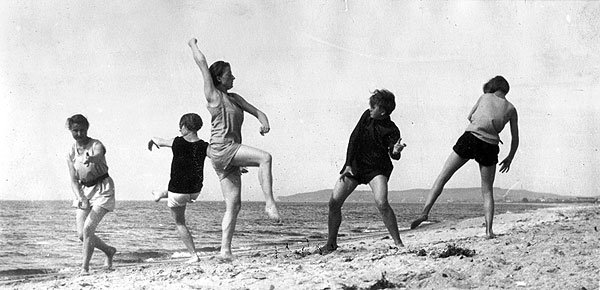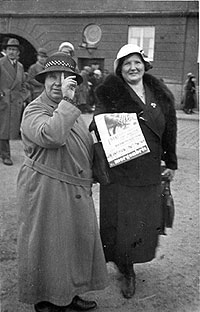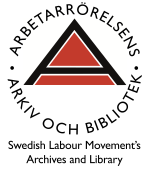Worlds of Women was a project that aims to inspire researchers, both academics and those actively interested in researching working women’s history, to look beyond national borders. This is an overview of available sources at the Labour Movement Archives and Library (ARAB) in form of essays and inventories.

Source: Archive of Morgonbris, ARAB.
This was a project financed by Riksbankens Jubileumsfond.
Introduction
Worlds of Women in ARAB’s Collections — A Short Introduction
by Silke Neunsinger
A global approach to feminist labour history adds new contents and insights. Our intention with this overview of available sources at the Labour Movement Archives and Library (ARAB) is to inspire researchers, both academics and those actively interested in researching their own history, to look beyond national borders.
Essays
Friendship beyond the Atlantic – Labor feminist international contacts after the second world war
by Dorothy Sue Cobble
Building on earlier research, I am now exploring the international dimensions of the story of U.S. labor feminism, recreating the transnational networks and international organizations in which labor feminists participated. Part of this project involves delineating the transatlantic connections between U.S. labor feminists and their counterparts abroad and the intellectual influence European and Nordic social justice feminism had on U.S. social policy in the post-World War II era. (ARAB-Working Paper 7.)
From Women’s Club to Group 8 – The Separate Organization of Women within the Swedish communist Movement
by Lars Gogman
Already in 1918 the first independent communist women’s organization was founded. The history of the organization of Swedish communist women shows how much room the internationalization allowed for a local formulation of the rules and structures which came from the international level. The history also shows how ideas were transformed from an international to a local context. (ARAB-Working Paper 5.)
Letters from Clara Zetkin
by Martin Grass
Clara Zetkin has sent letters sent both to the Social Democratic women’s organization and to leading Social Democrats in Sweden. There are only a handful of letters, but those to the representatives of the women’s organization tell a lot about the character of and conditions for women’s international work. Networking with men from the movement was often essential for women in order to develop their own organizations and groups and Zetkin’s letters to male leaders of the labour movement illustrate this. (ARAB-Working Paper 1.)
Brita Åkerman’s International Contacts
by Arne Högström
Brita Åkerman was active in different women’s organizations and was among the directors of Active Housekeeping, an information bureau within the State Information Board, and later even of the Swedish Consumers Agency. Her political work is yet another example of what was seen as typically Swedish, which, at the same time, was influenced by the developments outside Sweden. (ARAB-Working Paper 2.)
German-Speaking Refugee Women in ARAB’s Holdings
by Ulf Jönson
A modest amount of research has been done on women refugees. Is this due to a lack of women in the available archive material? Taking the collections of the Labour Movement Archives and Library (ARAB) in general, and in particular the Labour Movement Refugee Relief archive as the starting point, the aim here is to examine and catalogue what means are available for improving the state of research on women in exile. (ARAB-Working Paper 6.)
International Women’s Day a Prism for Women’s Political Work
by Silke Neunsinger
International Women’s Day is one of the socialist inventions that have spread and become a successful feminist celebration all over the world. The significance of International Women’s Day has certainly changed since its inception when it was intended to function as an international day for agitating for women’s suffrage to when it became an official United Nations Day in the 1970s to the present day when it is used by major companies to celebrate their outstanding female employee. (ARAB-Working Paper 3.)
Tales of Modernity, Peace, and Solidarity – Women’s Travelogues
by Lâle Svensson
Political tourism in a very broad sense has been important for the Swedish labour movement from the very beginning. Political tourism among women in the Swedish labour movement changed from journeys to the modern Soviet Union during the 1920s, to the war-stricken countries to help their sisters in need, and twenty years later to the Global South in order to support women’s projects in Africa and Asia. (ARAB-Working Paper 4.)
Inventories
Women’s archives at the Labour Movement Archives and Library
by Margareta Ståhl
Catalogue of women’s archives with an international profile at the Labour Movement Archives and Library, including a short presentation of the archives’ contents.
Covers some 50 archives and collections — people, associations, clubs, committees, federations etc. — ranging in time from 1902 to 2003.
Find Printed Sources on Women’s History
by Hans Larsson
Through our library catalogue Kata — named after the Swedish female socialist Kata Dalström — you can retrieve a lot of printed material concerning women.
An overview of useful subject headings and direct links to the catalogue.
Lists of international articles and reports in the Morgonbris journal
by Eva-Karin Annemark and Mats Myrstener

Selling Morgonbris. Photo: Lundh. Source: Archive of Morgonbris, 1810:58282, ARAB.
We have chosen to highlight particular recurring themes and topics, but also key people and countries mentioned in the journal during two time periods, referring to articles in Swedish only.
- International articles and reports in Morgonbris in the 1910s / by Mats Myrstener
- International articles and reports in Morgonbris in the 1970s / by Eva-Karin Annemark
Morgonbris, the journal of the National Federation of Social Democratic Women and it’s predecessors in Sweden, has been published since 1904.
It had an early international focus, as the inspiration for the Social Democratic women’s movement came from countries outside the Nordic region, such as Germany, Great Britain, and the United States, and the movement’s progress in these countries was continuously commented on in the journal. During the 1970s, international articles were dominated by reports and accounts from Africa, South America, and Asia, where peace and women’s rights were frequently recurring themes.
See also
The world in the basement
General presentation of international material in our collections. Downloadable digital version. Published in print 2002.
Resources on other websites
Socialist Internationals – a Bibliography
http://library.fes.de/library/english/si.html
Sources for Women’s and Gender History in IALHI-Member Institutions
http://www.labourhistory.net/gender/
Sources on the Development of the Socialist International 1907-1919 [Women 1907-1915]
http://library.fes.de/si-online/index.html
ViVa Women’s History
http://www.iisg.nl/~womhist/vivahome.php
Women’s History Collections (Gothenburg University Library)
http://www.ub.gu.se/%3C-sv,en%3E/kvinn/
Portals:
- Swedish Women’s Struggle for Suffrage
- Women’s Struggle for Knowledge
- Women at Work
- Women and Peace
- Love, Power and Sisterhood

